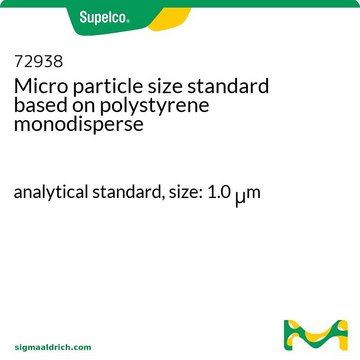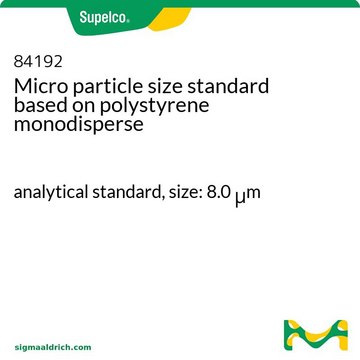80304
Micro particle size standard based on polystyrene monodisperse
analytical standard, size: 3.0 μm
Synonym(s):
Monodisperse polystyrene latex particles (3 μm), monodisperse polystyrene microbeads (3 μm), monodisperse polystyrene microspheres (3 μm), Size standards
Sign Into View Organizational & Contract Pricing
All Photos(1)
About This Item
Recommended Products
grade
analytical standard
Quality Level
form
aqueous suspension
particles
crosslinking
0 % cross-linked
concentration
2% (solids)
particle size
3.0 μm std dev <0.1 μm, coeff var <2%
application(s)
glass & ceramic
industrial qc
pharmaceutical
format
neat
storage temp.
2-8°C
Looking for similar products? Visit Product Comparison Guide
General description
Monodisperse polystyrene based micro particles (size: 3.0 μm) are a size standard, designed to identify the particle size distribution (PSD) profile of test samples.
Application
Used to validate and monitor the performance of particle sizing equipment.
Also used:
Also used:
- in acoustic traps to study the effect of non-contact retention of microparticles on trapping performance of lab on chip systems
- to synthesize microsphere-based interferometric optical probe called reflectophore
Features and Benefits
- suitable for routine instrument calibration checks and corrections
- available in 5 mL pack size as a neat sample
Analysis Note
For every lot exact values of particle size and standard deviation are determined with an accuracy of 0.001 μm. The size determination of these particles follows procedures described by National Institute of Standards and Technology (NIST, USA) respectively by the Community Bureau of Reference (BCR), esp.:
- Transmission electron microscopy (TEM)
- Scanning electron microscope
- Light microscopy
- Coulter™ counter with MDF-system
Legal Information
Coulter is a trademark of Beckman Coulter, Inc.
Storage Class Code
10 - Combustible liquids
WGK
WGK 3
Flash Point(F)
410.0 °F
Flash Point(C)
210 °C
Personal Protective Equipment
dust mask type N95 (US), Eyeshields, Gloves
Choose from one of the most recent versions:
Already Own This Product?
Find documentation for the products that you have recently purchased in the Document Library.
Customers Also Viewed
Frequency tracking in acoustic trapping for improved performance stability and system surveillance
Hammarstrom B, et al.
Lab on a chip, 14(5), 1005-1013 (2014)
Growth phenotype screening of Schizosaccharomyces pombe using a Lensless microscope
Penwill AL, et al.
Biosensors And Bioelectronics, 54(8), 345-350 (2014)
Yongjae Jo et al.
Nature communications, 9(1), 4577-4577 (2018-11-06)
Fluorescent optical probes have rapidly transformed our understanding of complex biological systems by providing specific information on biological targets in the natural living state. However, their utility is often limited by insufficient brightness, photostability, and multiplexing capacity. Here, we report
Our team of scientists has experience in all areas of research including Life Science, Material Science, Chemical Synthesis, Chromatography, Analytical and many others.
Contact Technical Service












